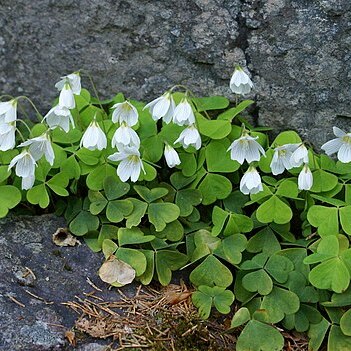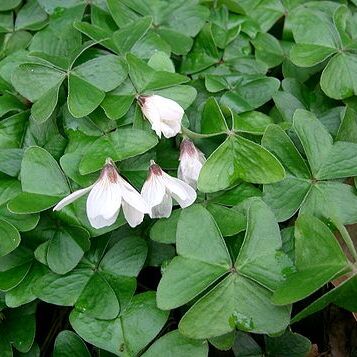Herbs or subshrubs, rarely lianas; roots branched fibrous or subligneous thickened; stems underground and reduced to an invisible disc covered with bracts and the base of petioles connate to the stipules, or modified in a more or less ligneous, thickened rhizome covered with the base of the decayed leaves, or aerial and climbing, decumbent, trailing or erect, subligneous at the base, or all herbaceous. Leaves alternate, apparently basal or cauline, subopposite or pseu-doverticillate, 3(-4)-foliolate, digitate or pinnate, with or without stipules connate to the petioles. Inflorescences axillary, of 2-branched or umbelliform cymes or solitary flowers; bracteoles 2; bracts small. Flowers varying in size, rarely cleis-togamous; calyx 5-partite; petals 5, connate near the middle; stamens 10, connate at the base, the series of 5 external alternisepalous stamens opposite the petals, shorter, the internal series alternipetalous, longer, usually all fertile; pistils het-erostylous, bi-, trimorphic, the carpels 1-15-ovuled, the styles 5, free, the stigmas capitate. Capsule globose, oblong to cylindric, glabrous or pubescent, the carpels (1-)2-15-seeded, loculicidally dehiscent, the carpels connate to the central axis, persistent; seeds generally ovoid, apiculate or oblong, more or less flattened, the testa crustaceous, longitudinally zig-zag ribbed, transversally striate or sculptured densely verrucate, 2-tegmic, the external integument fleshy, arilliform, breaking elastically and projecting the ripe seeds; albumen fleshy; embryo straight.
Caulescent or acaulescent perennial or annual herbs, bulbous or not. Leaves radical or cauline, alternate, digitately or pinnately (1–)3-foliolate, rather sensitive to light and drooping at night, petiolate, sometimes with membranous stipules adnate to the petiole. Flowers pedicellate, subtended by bracts, in pseudumbels or cymes or solitary, usually trimorphic heterostylous (largely homostylous in O. corniculata). Sepals sometimes with apical calli. Petals contorted in bud, falsely connate near the base. Stamens 10,2-seriate, with 5 outer short filaments opposite the petals and 5 inner long filaments opposite the sepals; filaments usually fused at the bottom to form a tube and sometimes the long filaments each with an appendage at the back; anthers opening by slits. Ovary of 5 fused carpels, with 1–many ovules in each carpel; stigma terminal, capitate, 2-fid or laciniate. Fruit a capsule, with the valves persisting around the central column. Seeds brown, covered by a white fleshy integument, which bursts elastically by contraction expelling the seeds when ripe.
Annual or perennial herbs (or dwarf shrubs, extra-Mal.), some stemless with rhizomes or bulbs. Leaves digitately or pinnately 3(-4)-foliolate; leaflets in Mal. spp. (except O. barrelled) ± sessile. Stipules when present adnate with the base of the petiole. Peduncles basal from bulbs or solitary and axillary. Inflorescences cymose to umbellate, 1-many-flowered. Bracteoles 2-several, sometimes with apical calli. Pedicels articulate at base and sometimes beneath the calyx. Sepals shortly connate at base, with or without apical calli. Petals coherent above the claw, contort, glabrous. Filaments: longer ones sometimes with a dorsal tooth. Stigma cylindric and minutely bilobed to peltate, sometimes papillose. Ovules 1 to c. 10, in 1-2 rows per cell. Capsules loculicid by longitudinal slits, sometimes with episeptal rimae. Seeds 1-c. 10 per cell, usually few; aril bivalved, ejaculatory; testa smooth, or with transverse ridges or longitudinal furrows.
Herbs [subshrubs, shrubs, or vines], caudex absent (present in O. dichondrifolia, O. frutescens, O. montana, and O. texana), usually with tubers, bulbs, or rhizomes, sometimes fibrous-rooted or taprooted. Aerial stems erect to decumbent, prostrate, or creeping, or absent. Leaves basal or cauline, palmately compound (pinnately compound in O. frutescens, 1-foliolate in O. dichondrifolia); leaflets pulvinate, usually 2-lobed, sometimes not lobed, often deflexed and folded together at night, laminae and margins often with black or orange oxalate dots or stripes. Flowers tristylous, distylous, semihomostylous (one whorl of anthers at level of stigmas, other proximal or distal), or homostylous (all anthers at level of stigmas); petals yellow, white, pink, salmon, red, lavender, purple, or violet; stamens: filaments 5 long and 5 short, alternating with one another, or equal length. x = (5–)7(–12).
Herbs, annual or perennial, usually with tubers, bulbs, or rhizomes. Stems erect, creeping, or absent (rosette). Stipules usually absent or very small. Leaves radical or alternate, 3-foliolate (Chinese taxa). Inflorescences solitary, cymose, or umbellate; peduncle long, with 2 small bracts at apex, bracts appearing to be mid peduncle in solitary-flowered species. Sepals distinct, imbricate. Petals yellow, red, pink, or white, convolute, sometimes basally slightly connate. Stamens all fertile; filaments basally connate or distinct. Ovary locules with 1 to several ovules. Capsule loculicidally dehiscent. Seeds with an outer fleshy coat which bursts elastically.
Herbs or occasionally shrubs. Lvs radical or cauline, mostly palmately compound, often with 3, entire or 2-lobed, sessile or shortly petiolulate leaflets, sometimes pinnately 3-foliolate, rarely 1-foliolate or phyllodinous. Stamens 10, in 2 whorls; carpels 5, united; styles 5, free.
Stamens 10, 2-seriate, the outer 5 shorter and opposite the petals, the inner 5 longer and opposite the sepals (vestiges of a third whorl sometimes present); filaments usually connate at the base and sometimes with dentate appendages; anthers introrse in bud, dehiscing by slits.
Stamens 10; carpels 5, completely united; styles 5. Ovules 1 or more per cell, capsule loculicidally dehiscent; testa bursting elastically. Herbs or subshrubs. Genus of 800 or more spp., widespread but mostly of S. Africa and S. America.
Leaves radical or cauline, alternate or often in a cluster, digitately 3-foliolate (in our area) or pinnately 3-foliolate or sometimes 1-foliolate.
Flowers actinomorphic, usually heterostylous (homostylous in O. corniculata), solitary or subtended by bracts in pseudumbels or cymes.
Seeds with or without endosperm and with a testa which becomes fleshy and eventually everts explosively ejecting the contents.
Caulescent or acaulescent annual or perennial herbs, usually bulbous, occasionally suffruticose.
Petals contorted, unguiculate; claws ± coherent to form a false tube.
Ovary with several ovules in each loculus; ovules anatropous.
Capsule loculicidally dehiscent.


